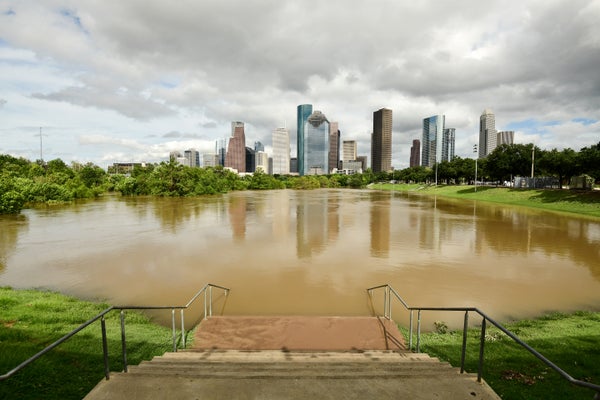WWW.SCIENTIFICAMERICAN.COM
Denver, Dallas among the Major U.S. Cities Sinking into the Ground
May 8, 20253 min readThe 28 Most Populous Cities in the U.S. Are All SinkingCities across the U.S., including inland ones such as Denver and Dallas, are settling into the earth, posing increased flooding risks and potentially damaging urban infrastructureBy Andrea Thompson edited by Dean VisserFlooding in Buffalo Bayou Park in Houston, Tex., following Hurricane Beryl in July 2024. Mathew Risley/Getty ImagesAll 28 of the most populous cities in the U.S. are sinking, worsening risks of flooding and damage to urban infrastructure, a new study finds. One of the main culprits is the extraction of groundwater to quench the thirst of growing populations and commerce.The research, published Thursday in Nature Cities, shows this subsidence is “ubiquitous—people should be looking everywhere” for it, says Cornell University geophysicist Matt Pritchard, who was not involved with the study.People have long known that certain cities around the world are sinking, particularly coastal ones. In the U.S., New Orleans has been perhaps the most famous example. This subsidence can have both natural and humanmade causes, such as ground that continues to respond to the retreat of the ice sheets, dams that prevent sediment from replenishing river deltas and buildings that weigh a city down.On supporting science journalismIf you're enjoying this article, consider supporting our award-winning journalism by subscribing. By purchasing a subscription you are helping to ensure the future of impactful stories about the discoveries and ideas shaping our world today.A few detailed studies have been conducted on some particular cities, such as Miami, but otherwise data have come from sparse, on-the-ground measurements that don’t reveal the nuance needed to properly gauge risks to infrastructure. To get granular data, the researchers behind the new study turned to interferometric synthetic aperture radar (InSAR) measurements taken from satellites. Study co-author Leonard Ohenhen, a postdoctoral researcher at Columbia University’s Lamont-Doherty Earth Observatory, explains that InSAR is akin to bouncing a ball at a steady rate against a wall. If the wall moves away from you, the ball takes longer to bounce back. If the wall moves closer, the ball returns more quickly. Similarly, in the new research, the pulses sent out by the InSAR device were able to detect upward and downward deformations of Earth’s surface down to the millimeter scale in grids made up of 28-meter squares.Amanda Montañez; Source: “Quantifying Land Subsidence Impacts in U.S. Metropolises,” by Leonard O. Ohenhen et al., in Nature Cities. Published online May 8, 2025The team found that in all 28 cities examined in the study—which each have populations of more than 600,000—at least 20 percent of their area was sinking. In 25 of them, at least 65 percent was subsiding. Nine cities—New York City, Chicago, Houston, Dallas, Fort Worth, Columbus, Seattle, Denver and Detroit—had an area-weighted average rate of subsidence of more than two millimeters per year. Houston, Fort Worth and Dallas had the highest rates of any of the cities, with an average of more than 4 mm per year. In fact, more than 42 percent of Houston is sinking faster than 5 mm per year, and 12 percent is sinking by more than 10 mm per year.Those numbers may sound small, but measurements began around 2015, meaning “it’s been 10 years at that rate—and that starts to add up,” Pritchard says. Also, damage can occur even with small displacements. “The value here is in detecting things before they get worse or at smaller more subtle scales,” he adds.This is particularly true when there are different rates of sinking across a city, or even areas where some ground is sinking and some is rising. The study showed how ground deformation varied across the cities—for example, the area around LaGuardia Airport is sinking much faster than most of the rest of New York City. These different rates can cause buildings to tilt and can lead to other infrastructure damage. “We have buildings that collapse from this type of ground deformation,” Pritchard says, citing conditions that might have played a role in the 2021 collapse of a condominium in the Miami suburb of Surfside, Fla.Of the 5.6 million buildings in the cities examined in the study, about 29,000 are in areas of concern. That doesn’t mean those buildings will necessarily be damaged; factors such as soil type, construction methods and building age can come into play. But it does show where a more detailed analysis should be done, Pritchard and Ohenhen say.Another subsidence-related concern is flooding. When you have areas of sinking in a city, it can create a “subsidence bowl,” Ohenhen says. “Where the land was flat, [water] could easily flow from one place to the other,” but now it gets trapped in that bowl instead.The reasons for the subsidence vary from city to city, and even within a city, but the team found that 80 percent of the sinking was associated with groundwater extraction. That points to the need to balance demand for water with maintaining aquifers to avoid collapse. Cities in drought-prone regions, such as Texas, should be particularly concerned because when drought sets in, “you a have a really, really high probability” of further subsidence as aquifers become more depleted, Ohenhen says.Pritchard says the study shows that subsidence is a problem outside of previous poster cities such as New Orleans—and that “we really we should be looking at this everywhere, not even just in large cities.”









